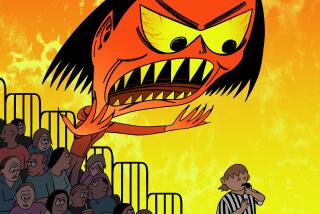Putting a Stop to the Epidemic of Violence
In the week after the Super Bowl, the police report at the NFL included one player indicted on murder charges, another arrested on drug and weapons charges, and two others charged with disorderly conduct.
For a league so conscious about its public image, the arrests were an ugly exclamation point to what is becoming an increasingly alarming problem.
During the season, another player was charged with murder, one was suspended after a drunken driving accident in which a woman was killed, another was charged with battery against his pregnant wife, two others were charged with sexual assault and another was arrested on burglary charges.
The violence is alarming. But it’s also preventable.
“What a lot of leagues need to do is take a closer look at character,” said Dr. Daniel Landers of Arizona State University, past president of the sports psychology division of the American Psychological Association. “When we recruit players, too often we recruit players who have had trouble. And they turn out to be more of a problem than they’re worth.
“We had a coach at Arizona State who’s no longer here, who recruited a basketball player out of prison. He thought he could rehabilitate him. The player was on campus two weeks when he raped a girl.”
That problem was predictable. Psychologists believe the best forecaster of future behavior is past behavior. Coaches and teams under pressure to win sometimes look the other way when stocking their rosters. The result can be trouble.
“These people take high maintenance cases who have to be watched over and counseled,” Landers said. “You don’t have to be an expert in psychology to know that’s a problem.
“When players are recruited, they should look to character and talent. Too often, they just look at talent. Socialization must be learned. If it’s not learned by college, that should tell a coach to stay away because this is a high maintenance case.”
And the same rule applies to the pros.
Dr. Richard Lapchick, executive director of Northeastern University’s Center for the Study of Sports in Society, thinks players need programs to help them control their anger. And he thinks they should go beyond casual one-hour seminars.
“Sadly, this is part of our landscape,” he said. “We live in a violent society, where violence is accepted and the tools are no longer fists, but lethal weapons. It’s naive not to expect it to filter into professional sports.”
Lapchick thinks there are solutions.
“A lot of sports deal differently with stars and end-of-the-roster guys,” he said. “If a guy is on the taxi squad and gets in trouble, he’s probably gone. If he’s a star, it’s not so certain he’ll be dismissed or suspended. They need to set up objective standards that let players know there will be serious consequences.
“Everybody deserves a second chance. I don’t know if they deserve it on the playing field.”
Each year, the NFL conducts a pre-draft scouting combine in Indianapolis where players are poked and probed, timed in the 40-yard dash, measured for their vertical leap. Psychological testing, however, is not part of the regimen.
“Some teams test,” said Duke Babb of National Football Scouting, which compiles data for 15 teams. “If they choose to, it’s done very informally during free time. But no, that is not a regular part of what’s done at the combine.”
One of the testing teams is the New York Giants. Dr. Joel Goldberg has been administering their program for 20 years and he said a number of teams including the New York Jets, Miami Dolphins and Atlanta Falcons are moving in that direction.
“We don’t look just at tests,” he said. “We use a variety of instruments. There is no certainty. We’re one accident away from the front page. We look at a player’s past and take a position. The Giants have a strong moral feeling about their players. It works.”
When trouble surfaces around the league, Goldberg said it’s easy to understand its origin. At the heart of the matter is the drive to win.
“The problem is, teams are unwilling to say ‘No,”’ he said. “Instead of taking a hard position, they get seduced. Coaches are paid to win, not to run a nice environment.”
Before the latest outbreak of violence, commissioner Paul Tagliabue said NFL players don’t get into trouble more than other people in society. Dr. Robert Burton, president of the International Society for Sport Psychiatry, thinks the commissioner might be right about that.
“We have that behavior among athletes because we have it among human beings,” he said. “On a daily basis, the acts of violence in the country are mind-boggling.”
Landers agreed and said it was unfair to paint football with a broad brush.
“In Phoenix, we have a lot of drive-by shootings and they’re not committed by athletes,” he said. “Lots of football players don’t run out and shoot people.”
The NFL employs about 1,800 players and just a handful get in trouble. The ones that do, however, remain a cause for concern.
More to Read
Go beyond the scoreboard
Get the latest on L.A.'s teams in the daily Sports Report newsletter.
You may occasionally receive promotional content from the Los Angeles Times.










